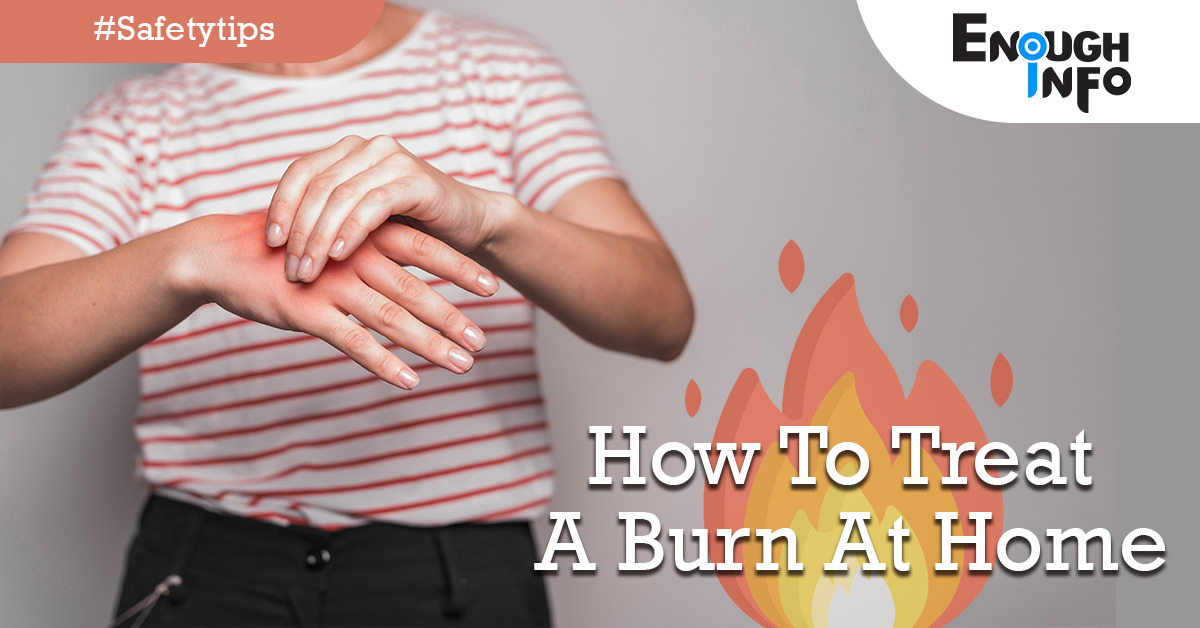How To Treat A Burn At Home (All you need to Know)

How To Treat A Burn At Home: Burns are a frequent but agonizing injury. Unlike severe burns, which need particular care to avoid infection and lessen the degree of scarring, minor burns often heal without much medical treatment. It’s crucial to know what type—or degree—of burn you have before beginning treatment. EnoughInfo.com

Read Also: How to Treat a Yeast Infection on Your Skin
FAQs & Answers on How To Treat A Burn At Home
1. What can I do at home to make my burn less painful?
To begin, apply a cool compress to the burn to help with pain relief. Apply pure aloe gel to your skin if it feels hot or itchy for relief. Taking over-the-counter pain relievers is an option if you’re still feeling discomfort or swelling.
2. What does a burn skin graft entail?
A skin transplant is a thin layer of skin that is removed from a bodily part that has not been burned and applied to a severely burned area. For third-degree burns and, to a lesser extent, second-degree burns, skin transplants are most frequently employed.
3. What should I know about chemical or electrical burns?
A specialist at a burn center should be consulted for any burns brought on by electricity or chemicals.
When to use home remedies for burns
Burns, whether from a cookie sheet, sunburn, or spilled coffee, are unpleasant. Most domestic injuries are burns. Burns are graded. First-degree burns are the least harmful since they just affect the skin’s surface. The only negative effects are redness, swelling, and mild discomfort. Second-degree burns, which impact deeper skin layers, cause blisters and white, wet, and glossy skin. Third-degree burns injure all skin layers, whereas fourth-degree burns can destroy joints and bones.
Medical situations like third- and fourth-degree burns require hospital treatment. Most first- and second-degree burns under 3 inches may be treated at home. Read on to discover the best and worst home cures for skin issues.
Read Also: How To Treat Turf Burn( Steps and Requirements)
First degree burns
All that is harmed in first-degree burns is the epidermis, or skin’s surface layer. The burn site is painful, dry, and red; there are no blisters present. One example is a minor sunburn. Rare cases of long-lasting tissue injury typically involve changes in skin tone.
The most frequent types of burns are those of the first degree, which can be caused by the sun, light contact with hot objects, and light scalding. Only the outermost, most superficial layer of skin is affected by the damage. They’ll probably seem red, a little bloated, and maybe even a little painful. Since first-degree burns typically don’t require specialized medical care, treat them at home. With attention and patience, the skin’s top layer can cure itself. How To Be A Good Father (The Ultimate Guide)
First-degree burns are categorized as “small burns” and are to be handled accordingly. It is not always necessary to seek medical assistance if you sustain a first-degree burn that is significant, such as a full-body sunburn. Quality Analyst Job Description
Second degree burns
This burn affects the epidermis and dermis. Swelling, red, white, or spotty skin may develop. Pain and blisters are painful. Second-degree deep burns may scar.
Blisters, blotchiness, and pain will worsen. Quick contact with boiling water, continuous contact with hot chemicals, and prolonged sun exposure create second-degree burns. Unless it’s on your face, hands, feet, or groyne, treat your second-degree burn as a mild burn. Don’t drain blisters. After draining, rinse the blister and apply antibiotic ointment with a cotton swab. Ointment can be covered with a bandage. Change this dressing daily. How to play guitar chords(All You Need To Know)
- Second-degree burns penetrate two skin layers. If your second-degree burn covers your hands, feet, joints, or genitalia, call your doctor immediately.
Third degree burns
Third-degree burns reach the subcutaneous fat. Tight, waxy, leathery, or dark skin may occur. These burns often require skin transplants.
Third-degree burns require immediate medical attention. These occur when prolonged contact with a hot item burns through all three layers of skin, sometimes damaging muscles, fatty tissues, and bones. Burns are leathery and white or black. Pain receptors depend on epidermal nerve injury. Protein leakage and cell breakdown make these burns “wet.” Software Engineer Job Description
- Third-degree burns always demand immediate medical intervention.
Look for low-temperature burns
These are “burns” that develop on your skin after being exposed to cold conditions, such as snow or ice, for a long time. As the skin is rewarmed, the region will appear bright red, white, or black and feel extremely scorching. Because it affects the skin’s tissue layers, even a low temperature “burn” is still regarded as a burn. How To Stop Masturbation (All You Need To Know)
- In the majority of situations, treat low-temperature burns as serious burns and seek medical attention.
- Immediately after exposure, rewarm the skin in 37°C (98.6°F) to 39°C (102.2°F) water.
Read Also: How To Treat Sunburn( Guide 2023)
Determine if you have a chemical burn
Another sort of burn brought on by coming into contact with dangerous substances that injure the skin’s layers is a chemical burn, and Finding out what caused the burn and calling poison control right away are always your first steps.
- If you think you may have experienced a chemical burn, call a poison control center right once. It is important to take precautions to contain and neutralize the chemical’s spread.
- Water should be used sparingly on chemical burns; however, if dry lime or elemental metals (such as sodium, magnesium, phosphorus, lithium, etc.) are present, they may react with the water and worsen the burn.
The top home treatments for burns
Mild burns normally heal entirely in a week or two without leaving any scars. Pain management, infection control, and expedited skin healing are the three main objectives of burn care. How to lose weight without exercise(The Ultimate Guide)
1. Iced water
Run cool (not cold) water over the burn area for around 20 minutes as soon as you notice a mild burn. Next, use a little soap and water to clean the burned area.
2. Cooling pads
An ice pack or clean, damp cloth applied to the burn area reduces pain and swelling. The compress can be used at 5- to 15-minute intervals. Avoid using cold compresses too frequently as this could aggravate the burn.
3. Topical antibiotics
Creams and ointments with antibiotics help stop infections. Your burn should be covered with cling film or a sterile, non-fluffy dressing after being treated with an antibiotic ointment like Bacitracin or Neosporin. Online drug stores sell Neosporin and Bacitracin.
4. Aloe Vera
The “burn plant,” aloe vera, is frequently praised. Aloe vera is beneficial in treating first- to second-degree burns, according to studies. Aloe has anti-inflammatory properties, enhances circulation, and prevents bacterial growth. Pure aloe vera gel extracted from an aloe vera plant’s leaf should be applied directly to the affected area. Make sure the aloe vera is present in large amounts if you get it from a store. Avoid additive-containing items, especially those with coloring or scents.
5. Honey
Just now, honey got tastier. In addition to having a wonderful taste, honey can be administered topically to treat small burns. Honey has inherent anti-inflammatory, antibacterial, and antifungal properties. How to clean a laptop screen(A Step-by-Step Guide)
6. Limiting time in the sun
Try your best to keep the burn from being exposed to direct sunlight. The skin that has been burned will be extremely sun-sensitive. Cover it with garments at all times.
7. Avoid popping blisters
Despite your temptation, refrain from touching your blisters. Self-bursting a blister might result in infection. Consult a doctor if you’re concerned about blisters that have developed as a result of your burn.
Read Also: How to Get Rid Of Acne
8. Use a nonprescription painkiller.
Take an over-the-counter (OTC) painkiller like ibuprofen (Motrin, Advil) or naproxen if you’re in pain (Aleve). For the correct dosage, make sure you read the label. How To Treat Scalp Psoriasis Naturally: 10 Home Remedies
Remedies to avoid
There are many strange home cures and urban legends for treating burns, but not everything your grandmother advises you to do is healthy. Avoid using the following typical home cures for burns:
1.Butter
Avoid applying butter on burns. Little to no research exists to back up butter’s efficacy as a burn treatment. Additionally, it can aggravate your burn. Butter holds heat and could also contain dangerous microorganisms that could infect burnt skin. Keep your butter for bread only.
2. Paste for teeth
On a burn, never use toothpaste. Another urban legend without any supporting facts is this one. Toothpaste could aggravate the burn and improve the chances of infection. And it’s not sterile.
3. Ice
In fact, ice and extremely cold water can aggravate your burn. If used incorrectly, ice could even result in a cold burn.
4. Oils
Contrary to common perception, not everything can be fixed with coconut oil. Oils like coconut oil, olive oil, and cooking oils retain heat in and can even make the skin burn longer for the same reason that you shouldn’t put butter on burns. Burns are said to heal faster with lavender oil, but there isn’t much published data to back this up. For instance, research on rats hasn’t revealed any advantages of using lavender oil to treat burns. How To Smoke Beef Ribs (The Ultimate Guide)
5. Egg-whites
Another urban legend claims that raw egg whites can contaminate skin and therefore never be used to burns. A reaction to eggs might also be allergic.
Read Also: 11 Benefits of Organic Skincare for Sensitive Skin
When to see a doctor
Knowing when to seek medical attention for a burn and when to manage it at home is crucial. A doctor should be consulted if:
- A large region larger than 3 inches in diameter is affected by a burn.
- if the burnt region is on the face, hands, buttocks, or groin, and if the wound starts to hurt or smell.
- Your body temperature rises.
- Your third-degree burn appears to be severe. How To Fix Crooked Toes (All you need to Know)
- if it’s been more than five years since your previous tetanus shot
Never attempt to treat third-degree burns at home. Serious consequences, including as infections, blood loss, and shock, are a possibility. A third-degree burn, sometimes known as a “full-thickness burn,” affects deeper tissues and may even cause nerve damage. Third-degree burn symptoms include:
- Waxy skin that is white
- char
- dark brown in hue
- texture that is elevated and leathery
Additionally, home therapy for electrical shock burns is extremely dangerous. These burns frequently penetrate layers beneath the skin and can even harm internal tissues. The inside harm can be more severe than you anticipate. Avoid taking any chances. Immediately dial 911. Take a look at this article in Spanish. How To Accept Criticism ( All you need to know )
Recovery from burns
The degree of your burn will determine how quickly it heals:
- Burns of the first degree ought to naturally heal without leaving scars after a week.
- Burns of the second degree should recover in around two weeks. Sometimes they do, but the scar might go away over time.
- Healing from third-degree burns might take months or years. They leave scars in their wake. To reduce these scars, you could require a skin graft.
Burn-related issues
Minor burns should disappear without posing any long-term issues. Scars and the following issues can result from deeper and more severe burns:
Infection
Burns, like any wound, leave an entrance that can let bacteria and other organisms in. Some infections are manageable and small. A potentially fatal infection known as sepsis can be brought on by bacteria entering your circulation.
Dehydration
Burns cause fluid loss in the body. Your blood volume may become insufficiently low if you lose too much fluid to deliver enough blood to your complete body. Immigrate To Canada As A Pharmacist
Low body temperature
Your skin plays a role in controlling body temperature. You can lose heat too quickly if it has been burned and is damaged. Hypothermia, a potentially harmful drop in body temperature, may result from this. AI And Blockchain: How They Work Together
Contractures
Your skin may become so tight from scar tissue after a burn that you are unable to move your bones or joints.
Injury to tissues and muscles
The structures underlying your skin could be harmed if the burn penetrates those layers.
Emotional difficulties
Particularly if they are on your face or other prominent regions, large scars can be disfiguring. The result could be emotional issues
Read Also: How To Treat Scalp Psoriasis Naturally: 10 Home Remedies
Conclusion
Burns are among the most frequent injuries at home, especially for kids. More than just the searing sensation connected to this injury is meant by the term “burn.” Severe skin injury that results in the death of the damaged skin cells is what defines burns.
Depending on the source and severity of the damage, most people can recover from burns without experiencing any severe health effects. For more severe burns, quick emergency medical care is necessary to avoid complications and death.
Recommended;
How To Practice Self Care(All You Need to Know)
How to Get Rid of Body Odor(2023)




